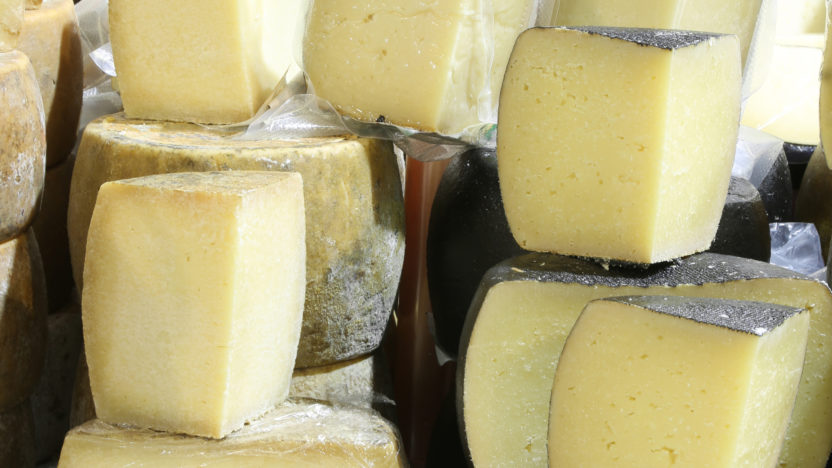 DOP
Toscana
DOP
Toscana
Pecorino of the Volterrane Balze
The Pecorino della Balze Volterrane is a Designation of Protected Origin (DOP) on the national list approved by the Ministry of Agriculture Food and Forestry, whose requirements are regulated by the production discipline of the Tuscany Region.
Features
The Balze Volterrane Pecorino must also have the following characteristics at the time of consumption:
– shape: flat-faced cylindrical with straight or slightly convex barefoot.
– diameter of faces: 10 to 30 cm.
– barefoot height: 5 to 15 cm.
– weight: from 600g to 2 kg, for the ‘fresh’, ‘semi-seasoned’ and ‘seasoned’ pecorino cheese, up to 7 kg for the “asserbo” pecorino cheese.
– crust: of varying color from straw yellow to loaded yellow; after treatment with olive oil and ash is gray.
– pasta: compact structure and minimal friability with any slight eyeling irregularly distributed; at the cut the color is variable from white for the type “fresh” to the more intense straw in the type “semi-seasoned”, “seasoned” and “from the axe”.
– scent: persistent reminiscent of milk and wild thistle, with hints of herbs and flowers.
– taste: at the first sweet taste, with hints of milk and florals and notes of thistle; long and persistent aftertaste with fresh vegetable references; slightly spicy finish, a feature that becomes more intense as the seasoning period increases.
Variety
The Pecorino del Balze Volterrane is a cheese produced exclusively with vegetable rennet and whole raw sheep milk, depending on the seasoning period, in four different types: – “fresh”, from 7 days to 44 days of storage; – “semi-seasoned”, from 45 days to 6 months of seasoning; – “seasoned”, from 6 months to 12 months of seasoning; – “to be abstained”, over 12 months of aging.
Production
The processing of the Pecorino of the Balze Volterrane involves the use of the following raw materials:
– Milk: sheep, raw and whole, produced from Sardinian-bred garments with a semi-brado system
– Renne: vegetable made from thistle or wild artichoke (Cynara cardunculus) blooms.
Salt: up.
The breeding system is semi-brado. Sheep feed is obtained for at least two-three of the total needs from grazing in the geographical area of origin. Preserved fodder and grains containing grains (barley, oats, favettes) are given in quantities ranging from 100g/head/die to 800g/head/die depending on the time of year, with the
higher concentrated values in the winter months and lower in the summer months.
Sheep cannot be fed genetically modified products (GMOs).
The milk destined for processing inPecorno of the Volterrane Balze smust not be subjected to any thermalization surgery and must be processed within 48 hours of the first milking.
Raw milk is poured into a copper or stainless steel boiler called a “pot” until it reaches a temperature of between 30 and 40 degrees Celsius. Vegetable rennet is added to the heated milk (from a minimum of 10ml to a maximum of 50 ml per 100 litres of milk).
The milk is allowed to clot for between 30 and 60 minutes. When the clot has reached a solid consistency, with the help of a tool called “spino”, the rupture of the same until the caseous lumps have reached the size of a hazelnut for the cheese “fresh”, “semi-seasoned” and “seasoned”, and a peanut or grain of rice for the ‘abstaining’ cheese.
For the preparation of the pecorino cheese, the curd can be kept in a warm environment (cooking process) at a temperature between 20 and 40 degrees C for a time ranging from a minimum of 60 minutes to a maximum of 180 minutes.
After breaking and possibly “cooking”, the curd is manually pressed into specific cylindrical forms of material suitable for food use and transferred to spersor tables, to facilitate the removal of the serum.
The salting should be done manually dry by sprinkled with salt the surface of the cheese, turning the product.
Within the next 10 days, depending on the size, the excess salt is removed from the surface of the cheese by washing the shapes with water.
The cheese is then placed to dry on light wood planks, preferably poplar and fir, in cool rooms at a temperature of between 6 – 16 degrees Celsius for a period corresponding to the seasoning times indicated in art. 2 for each type of cheese.
During the seasoning phase, the pecorino forms, with at least weekly frequency, must be overturned, brushed and washed with water to eliminate the mold that may be formed. Treatments with olive oil or salt-added oil, lean or poplar ash are allowed for pecorino cheese.
For products with a seasoning of more than 30 days, part of the maturing process can take place in tuff caves, or clay pits, or cellars.


